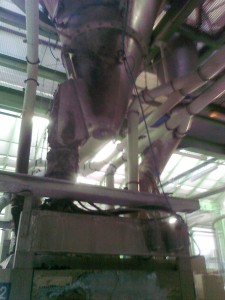A fire broke out around midnight in a sodium percarbonate storage hopper intended to supply the powder assembly and compression installation of a cleaning products plant. The workshop was evacuated while employees sprayed down the hopper, emptied the remaining powder onto the ground and put out the fire with powder extinguishers and water hoses. When the fire brigade arrived, the fire was contained, but an ammonia smell was noticeable. The origin of the smell was not determined, as the products used did not contain nitrogen. Measurements indicated a concentration of 108 ppm. The emergency services left the site at 3 a.m. when the ammonia concentration was down to 40 ppm.
The electrical control cabinet in the detergent production unit was destroyed and the hopper was damaged. The extinguishing water was confined to the site and then pumped out for evacuation and disposal.
The Classified Facilities Inspection authorities were informed.
The equipment had been shut down at 5:00 p.m., with 300 kg of sodium percarbonate remaining, under mechanical agitation, though the product should have been removed. The product, which was an oxidiser, self-ignited in the pellet hopper. The use of oxidisers on the pelletising lines is subject to strict and specific instructions due to the risk of fire; two of these instructions had not been followed. After a power outage during the day, the software monitoring the thermal sensors had stopped working and was not restarted by the staff. The temperature rise was not detected, so the temperature alarm did not signal the damage. In addition, the product had remained in the hopper (between 2 packaging operations) for more than 5 hours.
The ammonia may have come from a previous production operation (pool care products or disinfectant, etc.). However, the hopper did not have areas that would allow powder to accumulate and the bag filter is automatically cleaned by compressed air.
The plant operator noticed a deviation in the application of specific procedures. An action plan was set up to raise awareness of good practices among manufacturing technicians, even for long-time employees, and increased the display of instructions.




